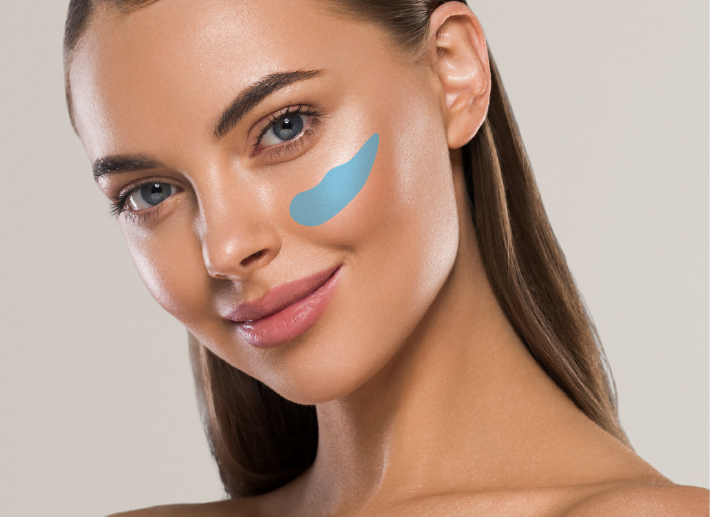Have you ever heard someone say, “Their eyes just naturally slant downwards”? They were probably talking about negative canthal tilt, a subtle yet noticeable feature of eye anatomy that plays a surprising role in our perception of facial aesthetics.
While often discussed in the realm of eyelid surgery, understanding negative canthal tilt requires us to go beyond superficial appearances and delve into the fascinating interplay of bones, muscles, and ligaments that shape our eye appearance.

Table of Contents
Beyond the Basics: Defining Negative Canthal Tilt
Before we plunge into the depths of negative canthal tilt, let’s ensure we’re on the same page. Picture this: imagine drawing a straight line connecting the inner eye corner, where your top and bottom eyelids meet near the nose, to the outer eye corner, where they meet near your temple. The angle of this line, my friend, reveals your canthal tilt.
- Positive canthal tilt, like a cat’s eye, means the outer eye corner sits higher, giving that alluring “upward” slant.
- Neutral canthal tilt is the Goldilocks of eye tilts—perfectly level.
- Negative canthal tilt occurs when the outer eye corner dips below the inner eye corner, resulting in a downward slant.
But negative canthal tilt is more than just an angle on a diagram. It’s about the interplay of the eyelid position with the surrounding structures, and how this affects overall facial harmony.
The Why Behind the Droop: Causes of Negative Canthal Tilt
Now, what causes this downward slant? Why do some of us have eyes that naturally look a bit droopy, even when we’re wide awake and full of beans? Let’s investigate!
- Genetics: Just like your hair color and height, your eye shape, including your canthal tilt, is often determined by good ol’ genetics. Thanks, Mom and Dad!
- Aging: Ah, the inevitable march of time! As we age, the ligaments that support our eyelids, like tiny little scaffolding, tend to weaken. This can lead to a gradual descent of the outer eye corner, resulting in a more pronounced negative canthal tilt.
- Medical Conditions: In some cases, negative canthal tilt may be associated with certain medical conditions. For instance, congenital conditions present at birth or facial paralysis can influence eye position and canthal angle.
Beyond Tired Eyes: The Impact of Negative Canthal Tilt
“But,” you might ask, “does a little downward slant really matter?” Well, in a world obsessed with eye aesthetics, it can. Here’s why:
- The Perception of Emotions: We instinctively associate a downward eye tilt with sadness, fatigue, or even anger, regardless of the actual emotion being conveyed. This can lead to misunderstandings or misinterpretations of facial expressions.
- The Illusion of Age: Because negative canthal tilt can become more pronounced with age, it often contributes to an “aged appearance,” even in younger individuals. This can be particularly frustrating for those who feel youthful and vibrant on the inside but feel their eye appearance doesn’t match their energy.
- Social Media and Beauty Standards: Thanks to platforms like TikTok and Instagram, discussions around eye shape and canthal tilt have exploded. While these conversations can be informative, they can also perpetuate unrealistic beauty standards and create unnecessary anxieties.
Correcting the Tilt: From Subtle Enhancements to Surgical Interventions
So, you’re probably wondering, “Can I do anything about my negative canthal tilt?” The good news is, you have options!
- Makeup Mastery: Makeup artists have a treasure trove of techniques to address a multitude of concerns, including minimizing the appearance of negative canthal tilt. Strategic application of eyeliner and eyeshadow can create the illusion of a more lifted outer eye corner, subtly altering the perceived eye tilt.
- Non-Surgical Treatments: For those seeking a minimally invasive approach, certain non-surgical treatments can provide temporary lifting and tightening effects. These might include radiofrequency therapy or ultrasound treatments that target the delicate skin around the eyes, known as the periorbital area.
- Surgical Options: When it comes to permanent correction of negative canthal tilt, surgical procedures are the gold standard. Canthoplasty and canthopexy, performed by skilled oculoplastic surgeons, involve repositioning and tightening the ligaments that support the outer corner of the eye, creating a more lifted and youthful eye contour.
It’s important to remember that eyelid surgery, while effective, is a significant decision. A thorough consultation with a qualified and experienced oculoplastic surgeon is crucial to discuss your individual needs, expectations, and determine the best course of action.
The Bottom Line: Embracing Your Unique Gaze
While negative canthal tilt is often discussed in the context of eye aesthetics and rejuvenation, it’s crucial to remember that beauty is multifaceted and extends far beyond a single facial feature. Your eye shape, whether it boasts an upward slant, a level gaze, or a gentle downward tilt, is part of what makes you uniquely you.
If you’re considering addressing your negative canthal tilt, remember to do your research, consult with qualified professionals, and make choices that align with your personal goals and values.
Visit Dr.MFO Instagram profile to see real patient transformations! Get a glimpse of the incredible results achieved through facial feminization surgery and other procedures. The profile showcases before-and-after photos that highlight Dr. MFO’s expertise and artistic vision in creating natural-looking, beautiful outcomes.
Ready to take the next step in your journey? Schedule a free consultation with Dr. MFO today. During the consultation, you can discuss your goals, ask any questions you may have, and learn more about how Dr. MFO can help you achieve your desired look. Don’t hesitate to take advantage of this free opportunity to explore your options and see if Dr. MFO is the right fit for you.




